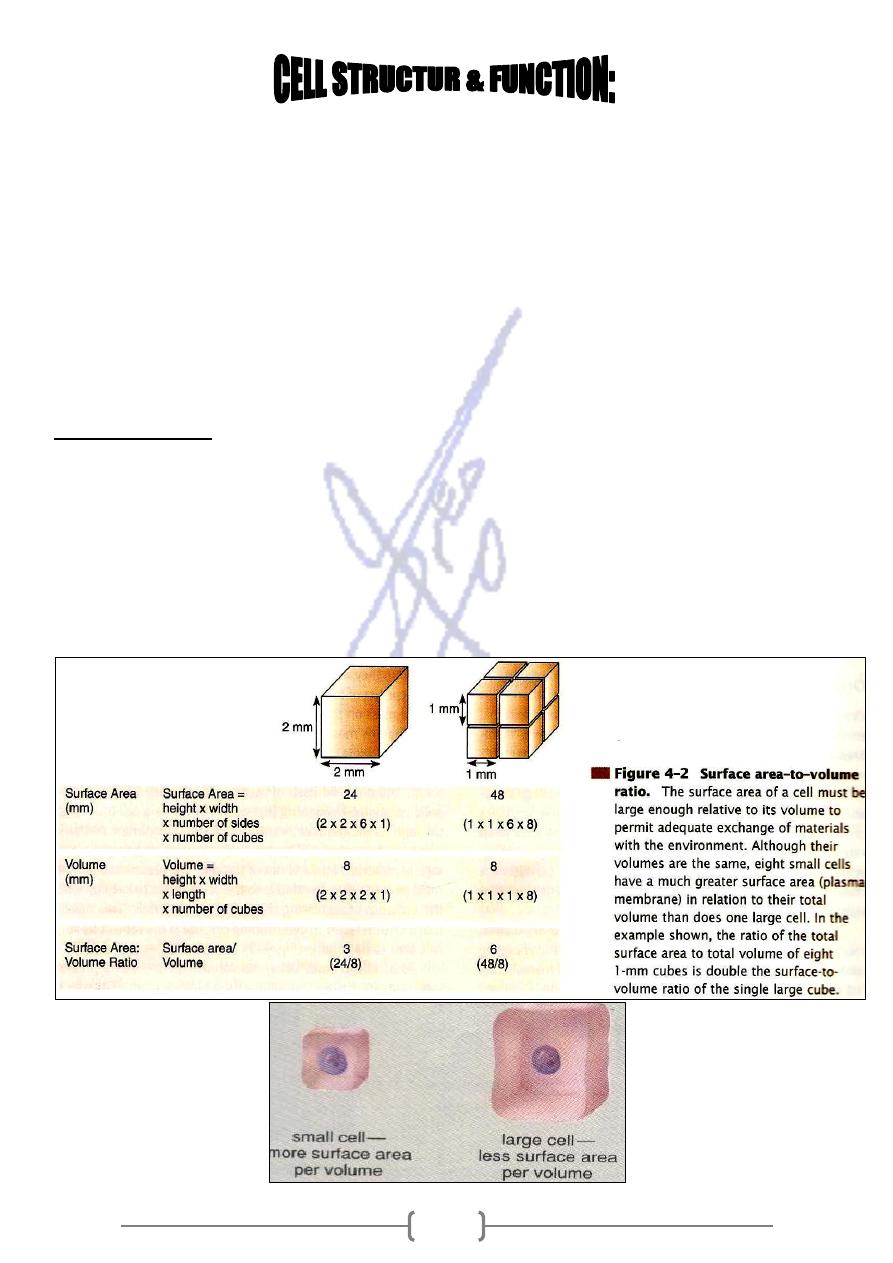
31
All organisms are composed of cells, the smallest units of living matter.
Cells are capable of self – reproduction, and existing cells come only from preexisting
cells (CELLS THEORY).
In 1838-1839 Matthiais Schleiden & Theodor Schwann were the first to point out the
plants & animals are composed of cells.
1855 Virchow proposed that the new cells are formed only by the division of
previously existing cells.
In 1880 August Weisman, was pointed that the ancestry of all the cells alive today
can be traced back to ancient times.
CELLS ARE SMALL:
A cell needs a surface area that can adequately exchange materials with the
environment.
Surface – area to volume considerations require that cells stage small.
A small cube that is 1mm. tall has a surface area of 6 mm
2
& a volume of 1mm
3
.This is
a ratio of surface area to volume 6:1.But a cube that is 2mm tall has a surface area of
24 mm
2
and a volume of 8 mm
3
. This is a ratio of only 3:1.
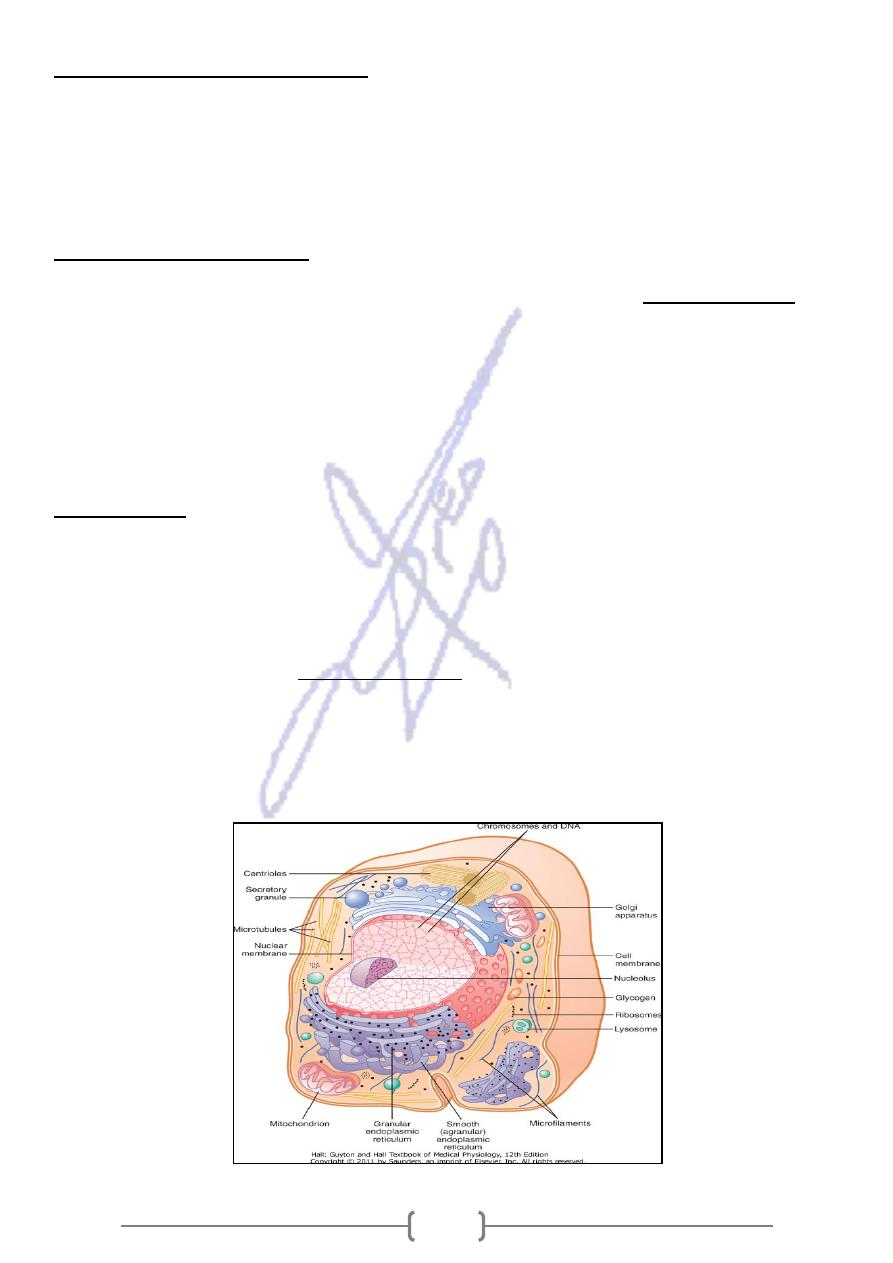
31
There are two major groups of cells:
Prokaryotic & Eukaryotic .Both have a plasma membrane & cytoplasm.
Eukar.cells have a nucleus & various organelles.
Proka .cells have anucleotide that is not bounded by nuclear envelope . They also lack
most of the other organelles that compartmentalize euka .cells
ORGANIZATION OF THE CELL:
Every cell is surrounded by plasma membrane which serves as a selective barrier
between the cell & its surrounding environment.
Cells have genetic instructions coded in DNA.
Cells have internal structures called ORGANELLES have specific function .
Cell size & Shape are related to function.
Cells are quit small ex. a frog's egg, at about 1mm .others cell are measured in
nanometer nm. .
Eukaryotic cell:
Have a true nucleus : which is a membrane bounded structure where DNA is housed
within thread like structure called chromatin
In eukaryote, organelles are small membranous bodies each with a specific structure
& function.
The cytosol which is a semi fluid medium outside the nucleus, is divided up &
compartmetalizated by organelles.
Compartmentalization keeps the cell organized & keeps it various functions separate
from one another.
The cytosol in eu. Cell has organized lattice protein filaments (cytoskeleton).
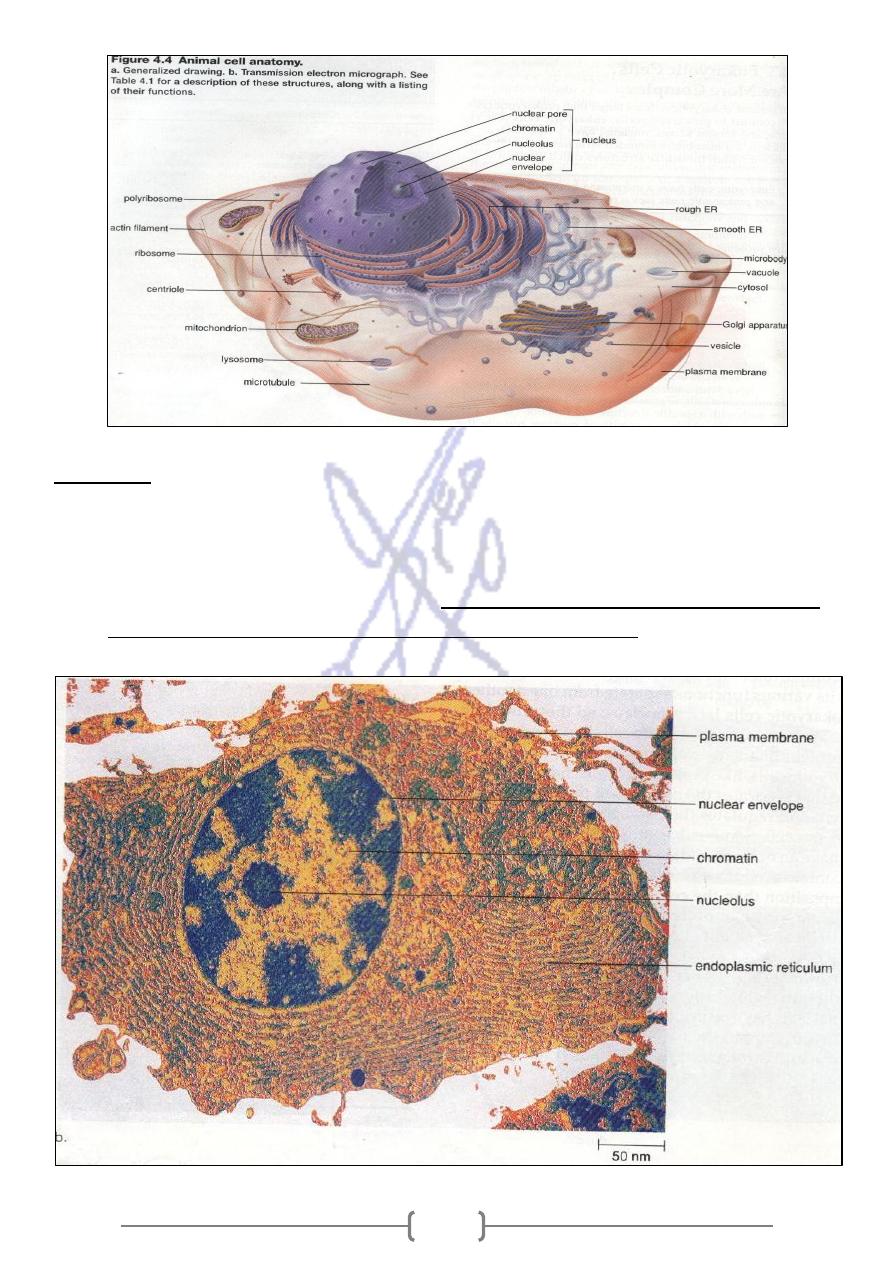
32
1-Nucleus
: Diameter of about 5µm, 1t stores genetic information that determines the
characteristic of the body’s cells &their metabolic function.
Every cell contains a complex copy of genetic information, but each cell type has
certain gene. DNA chromatin (chromosome) contains DNA & much protein.
Chromatin is immersed in a semi fluid (Nucleoplasm). it is a threadlike material that
undergoes coiling into rod like structures called chromosomes
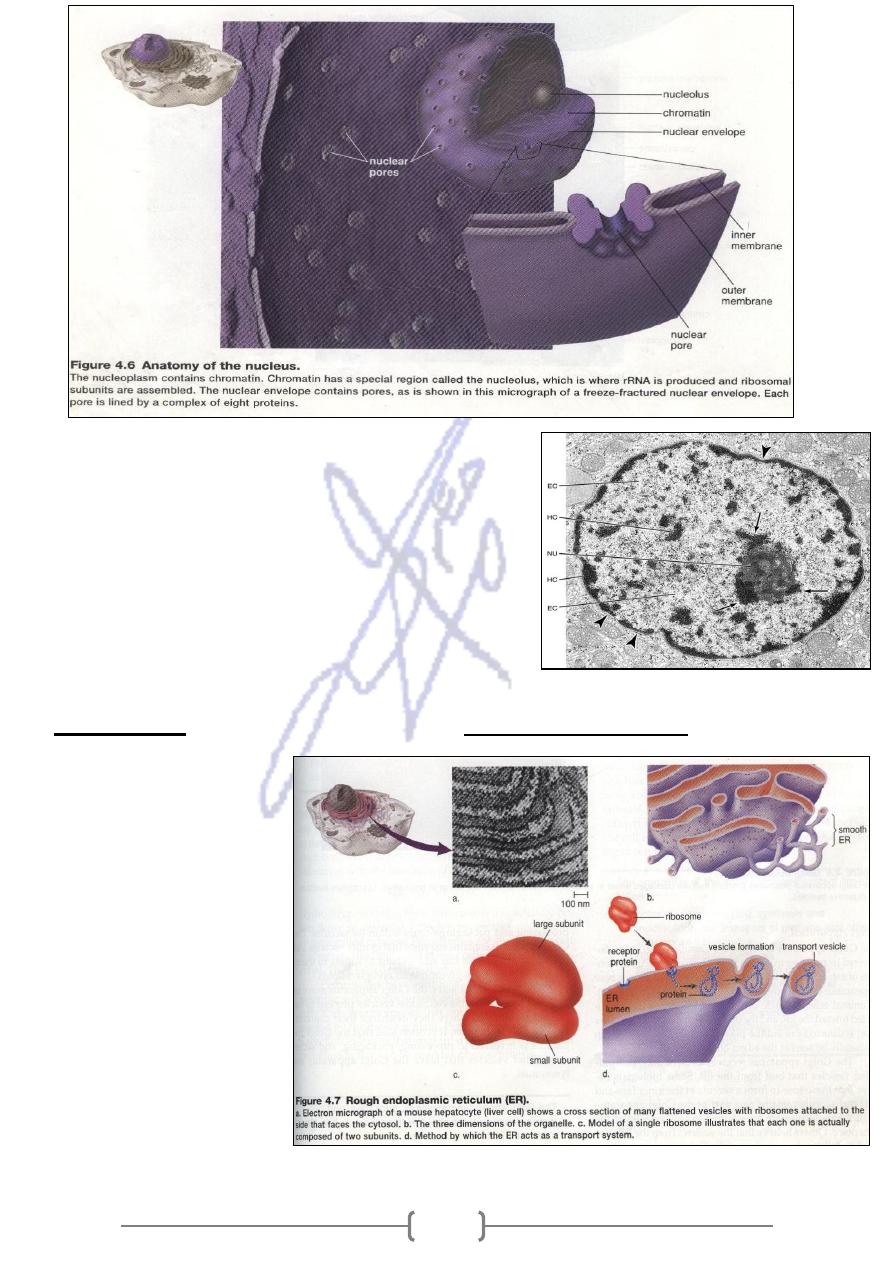
33
The nucleus is separated from the cytoplasm by
a double membrane known ( Nuclear envelope )
the inner membrane of N.E. composed of
protein& fiber called (nuclear lamina ) which
keeps :
1- The shape of the nucleus.
2-
Organize
chromatin.
3- May funnel substances toward or away from
the nuclear pores.
2- Ribosomes
: Are sites of protein synthesis it is found in both pro &euk. are slightly
smaller in prok. They are
composed of 2-subunits,
large & small. *Ribosome
occurs: 1-free within the
cytosol. Either single or in
groups called
polyribosome .They are
often, attached to the
endoplasmic reticulum
ER→RER.
SER= smooth ER, without
attached ribosome
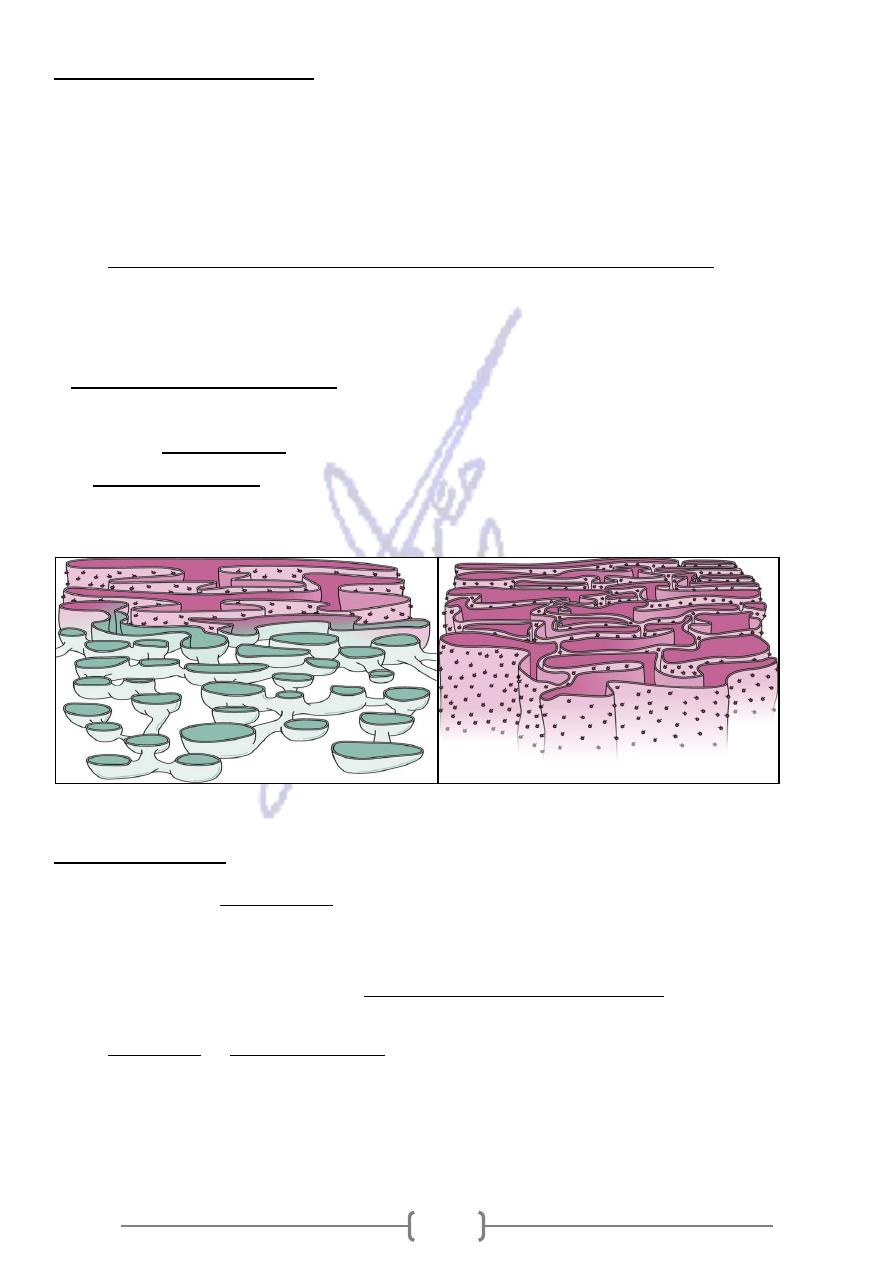
34
Endomembrane System
-
3
It consists of
a. Nuclear envelope b. Endoplasmic reticulum c. Golgi apparatus d. Vesicles
This system compartmentalizes the cell so that particular enzymatic reactions are
restricted to specific regions.
It is a complicated system of membranous channels & saccules (flattened vesicles) is
physically continuous with the outer membrane of the nuclear envelop
A- Rough E.R is studded with ribosome on the side of the membrane that faces the
cytoplasm (protein syn.).
B- Smooth E.R continuous with RER. It
1-synthesizes the phospholipids that occur in membranes, in addition to other function:
2. In testes, it produces testosterone.
3. In liver, it helps detoxify drugs.
4. It also forms vesicles in which large molecules are transported to other parts of the cell
often these vesicles are on their way to the plasma or golgi apparatus
GOLGI APPARATUS:
Is named for camill Golgi , consists of stack of 3-20 saccules the inner face is directed
toward the ER and the outer face is directed toward the plasma membrane
Its functions processing, packaging & secretion.
It receives vesicles containing protein & lipid which bud from ER ,so called ER vesicles
continually pinch off from ER& fuse with the golgi App to process and form
Lysosomes, & secretory vesicles .
2- Proteins & Lipids may be modified by enzymes from Golgi. app. & a sugar chain
may be added to them to become Glycoprotein & Glycoliped.
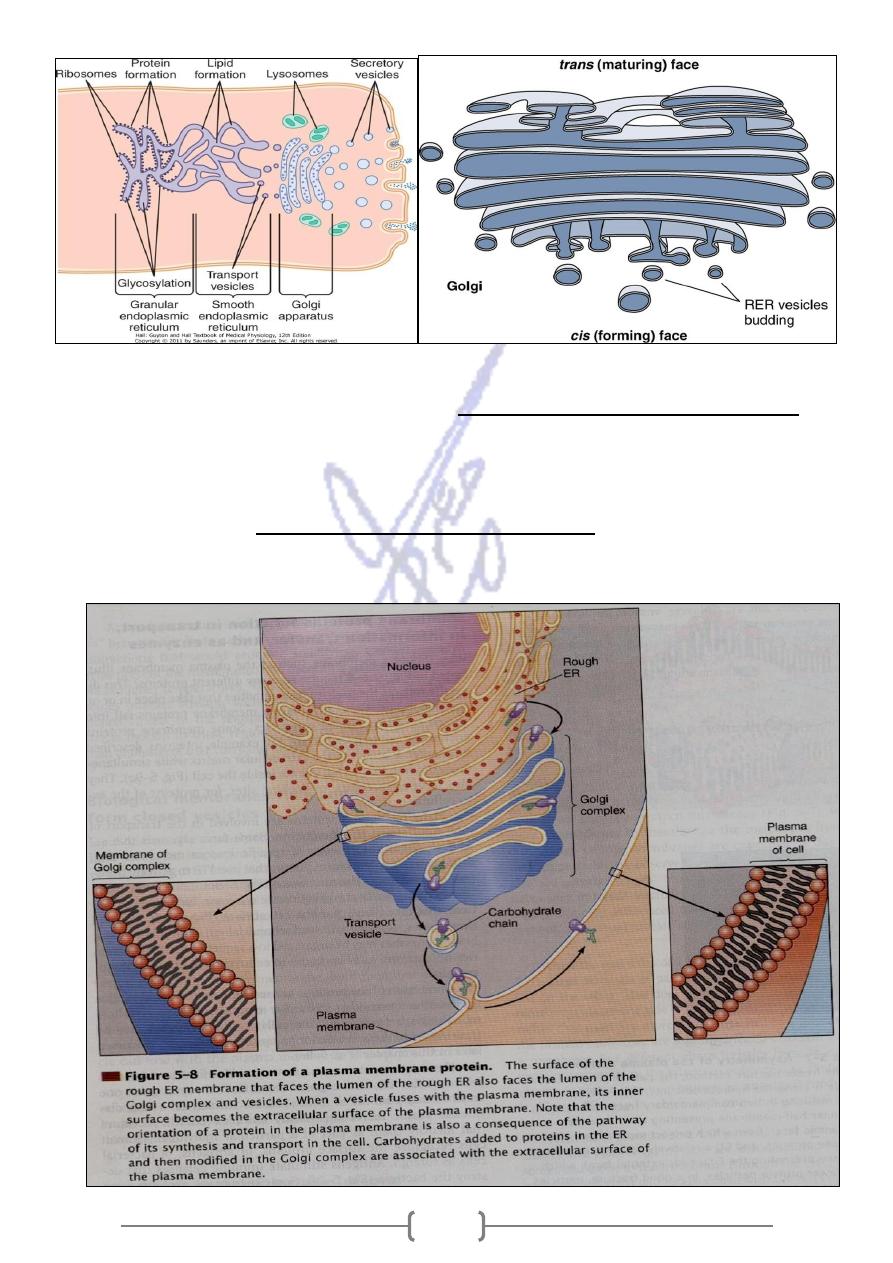
35
The vesicles that leave Golgi .app. Called secretory vesicles‘ or secretory granules
may proceed to the plasma memb . Where they discharge their contents. Because
this is secretion, it is often said that the Golgi app. is involved in processing, pack.,
secretory.
Ex. the transport of mucous, insulin & digestive enzymes.
Other vesicles that leave the Golgi apparatus are lysosomes

36
LYSOSOME:
Membrane bounded vesicles produced by the Golgi app. Lysosomes provide an intracellular
digestive system, ‘ which contain hydrolytic digestive enzymes ,that allows the cell to break
down complex molecules –lipids ,proteins , carbohydrates ,and nucleic acid . About 40
different digestive enzymes have been identified.
Macromolecules are brought into a cell by vesicle formation at the plasma memb. When
lysosome fuses with such a vesicle, its contents are digested by lysosomes enzymes.
Break down the contents of damaged cell ex. W.B.C. with bacteria in vesicles fuse with
lyso. are digested.
Even part of a cell are digested by its own lysosomes called (out digestion) which is
important during development ex: the fingers of a human embryo are at first webbed , but
they are freed from one another as a result of lysosomal action

37
Primary lysosome: - Formed by Golgi app., their hydrolytic enzymes synth. in RER . One or
more primary lysosomes fuse with the vesicle containing the ingested material , forming a
large vesicle a secondary lysosome .under some conditions lysosome break down
organelles so that their components can be recycled or used as an energy source
In certain genetic diseases of humans, known as lysosomal storage diseases, one of the
normally present digestive enzymes is lacking, its substrate substance that the enzyme
would normally break down accumulates in the lysosome, ultimately interfering with
cellular activities. ex. Tay-sachs disease, in which normal lipid cannot be broken down in
brain cells , the lipid accumulates in the cells, resulting in mental retardation & death
Microbodies : Are membrane –bounded vesicles that contain specific enzymes imported
from cytocol.
Peroxisomes : Are micro bodies that have enzymes for oxidizing certain organic substances
with the formation of hydrogen peroxide (H2O2)
RH2 + O2 R + H2O2 , toxic molecule , is a highly oxidizing substance, is broken down
to H2O + O2 with other peroxisomal enzyme (catalase)another oxidase enzyme present in
large quantities in peroxisomes, to oxidize many substances that might otherwise be
poisonous to the cell..
Peroxisomes are abundant in cells that metabolize lipids & in liver cells that metabolize
alcohol. They help detoxify alcohol.
They are formed by self- replication’ and contain oxidizes rather than hydrolyses
Vacuoles: - are large membranous Sacs . vesicles in the protozoans are quite specialized , &
they include
1- contractile vacuoles for ridding the cell of excess water
2- Digestive vacuoles (food vacuoles) vacuoles play a significant for breaking down
nutrients. Vacuoles play a significant role in plant growth and development.
Energy related organelles:
The cell obtains energy in the form of chemical energy in food molecules ( such as
glucose ) or from light energy.
Energy take place in
1- Cytosol.
2- mitochondria & chloroplasts
Chemical energy stored in ATP_ drive chemical reaction in the cell.
Mitochondria & chloroplasts contain small amount of DNA that code for some of their
proteins. These interesting organelles grow & produce themselves
Mitochondria It called “powerhouses” of the cell.
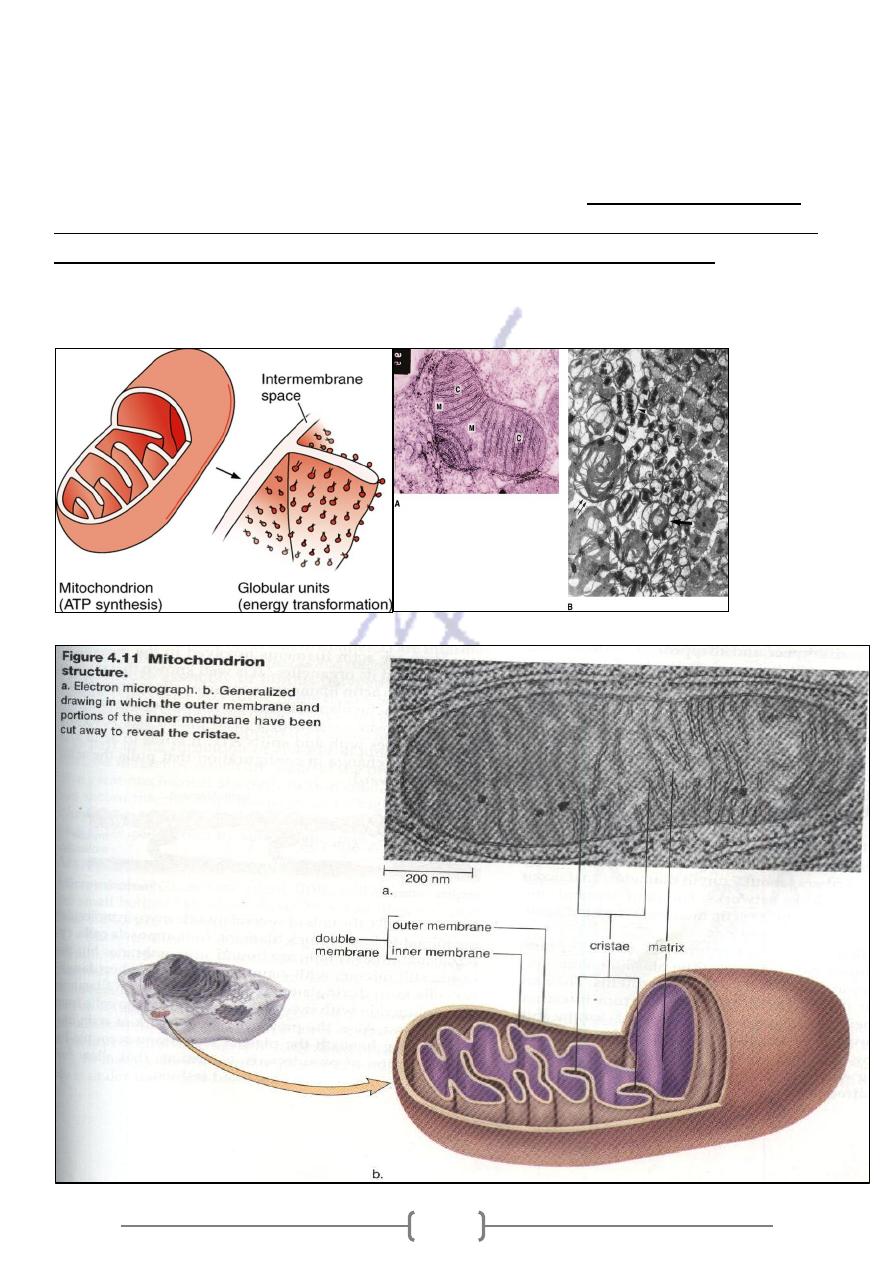
38
( 0.5 _ 1.0) µm in diameter & 2.5µm in length. Are bounded by double membrane
The outer mitochondria memb. is smooth & allows many small molecules to pass through
it.
The inner mito. Memb., form shelves or cisternia with oxidative enzymes are attached
In addition, the inner cavityis filled with a matrix that contains dissolved enzymes which
operate in association with the oxidative enzymes on the shelves to cause of oxidation of
the nutrients , and forming carbon dioxide and water with releasing energy. Energy is used
to synthesize ATP which transported out of the mitochondria ,wherever it is needed for
performing cellular functions

39
Mitoch. Are most numerous in cells that are very active (more than 1000 mitoch.,( in a
single liver cell)
In mammalian cell each mitoch, has 5_10 identical circular DNA links with genetic
diseases, including a form ;
1- of young adult blindness & progressive muscle degeneration.
2_ Mitoch. Also affect health & aging by leaking electron_ from free radicals toxic, these
electrons bond with other compound in cell, interfering with normal function.
3_ Mitoch. Play role in programmed cell death or apoptosis (is a normal part of an
organism's development & maintains) ex. Cells in the intestinal wall are continuously
destroyed & replaced by new cells.
Inhibition of apoptosis is may contribute to a variety of diseases including cancer,
acquired immunodeficiency syndrome (AIDs) & Alzheimer's disease.
CYTOSKELETON
1-The shape of cells & their ability to move are determined in large part by the
cytoskeleton, a dense of network of protein fibers.
2- Transport of materials & 3_ in cell division. It is made of 3 types of protein filaments:
1-Microtubules 2- microfilaments- Are fiber formed from beadlike, globular protein
subunits, which can rapidly assembled & disassembled.
( also known as actins filaments)
3-Intermediat filaments: Made from fibrous protein subunits & are more stable than
microt. µfila.
1-Microtubules: are hollow cylinder:
Are the thickest filaments of cytoskeleton. They are 1- involved in the movement of
chromosomes during cell division.
2- They are the major structural components of cilia & flagella.
3- They made of alpha – tubulin & beta tubulin. Microtubules have 13 rows of tubulin
dimmers.
The regulation of microtubule assembly is under the control of microtubule organizing
center, MTOCs. Centrosome a structure that is important in cell division.
The centrosome contain two centrioles. These structures which are oriented within the
Centro some at right angles to each other are known as 9 × 3 structures, The centrioles are
duplicated before cell division
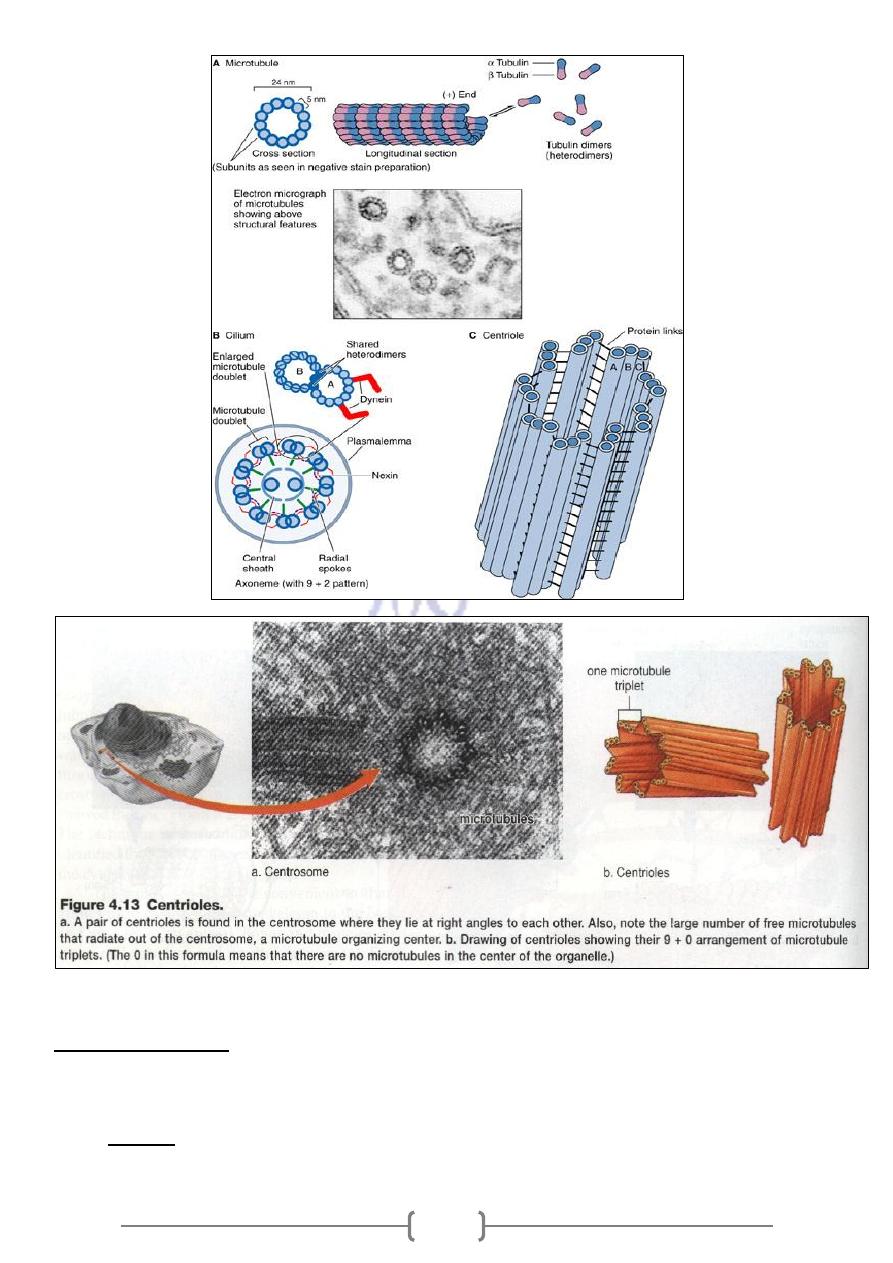
41
CILIA & FLAGELLA
: are composed of Microtubules projecting from surface of many cells,
thin , movable structures important in cell movement .
Flagella are long single or only few (200μm) in animals flagella serve as the tail of
sperm cells.
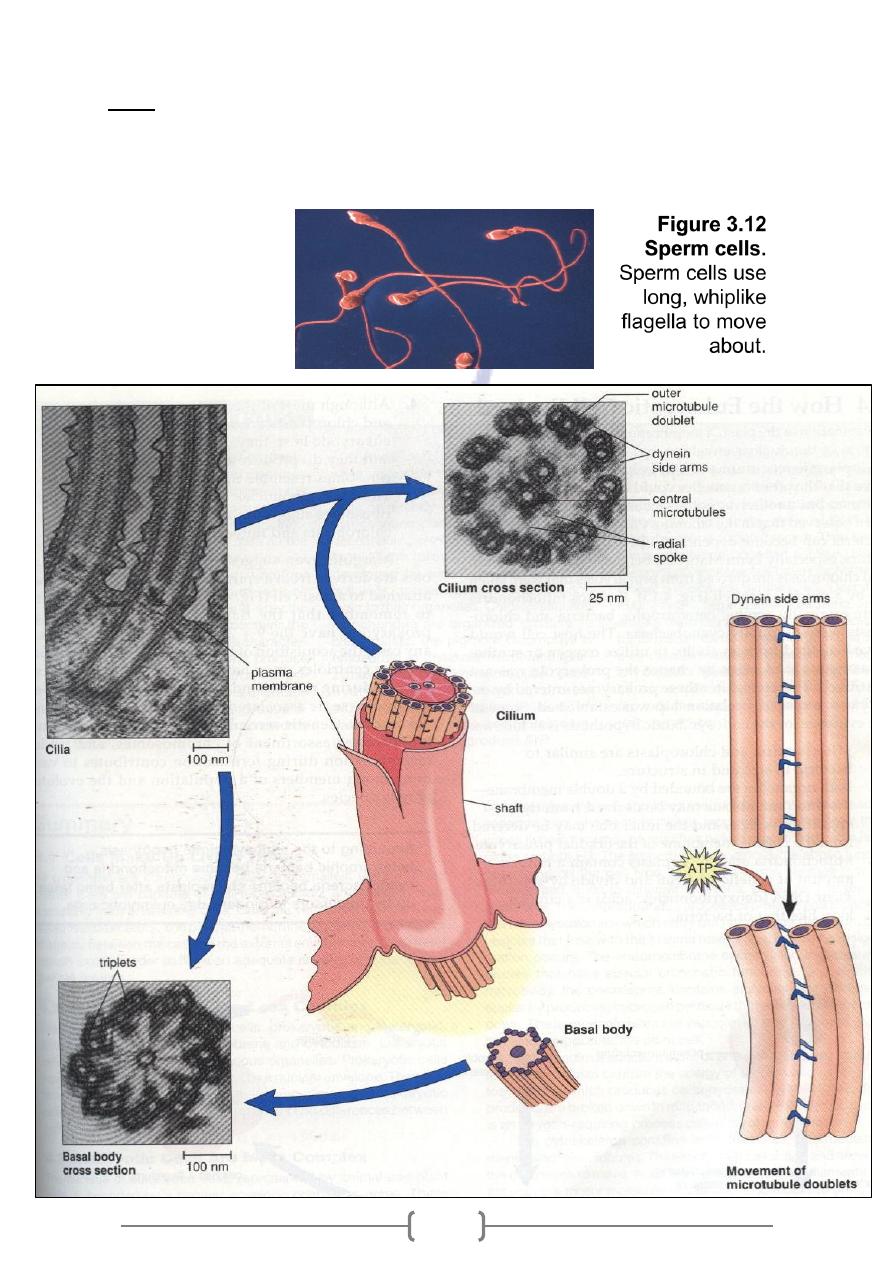
41
Cilia _ has many short (2-10 μ m) appendages. These structures are found on
unicellular & small multicelular organism. In animals cilia occur on the surfaces of
cells (e.g. respiratory passage ways).
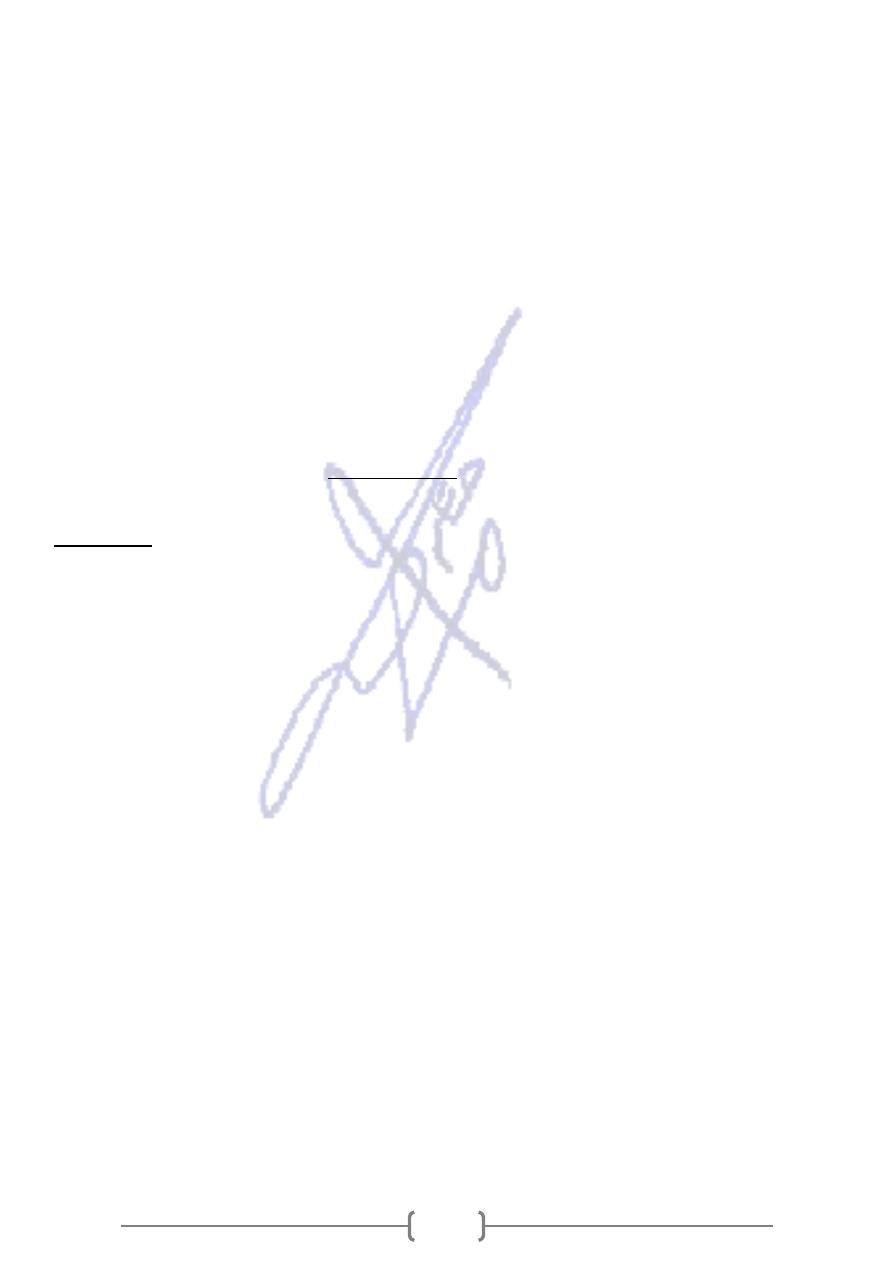
42
Eukaryotic cilia & flagella are structurally alike. Each consists of a slender, cylindrical stalk
covered by an extension of the plasma membrane. The core of the stalk contains a group of
microtubules arranged as 9+2 of microtubules.
Each cilium or flagellum is anchored in the cell by a basal body, which has a set of three
attached microtubules.
(9x3 structure).
2-Microfilaments: consist of intertwined strings of actin called also actin filaments, flexible
solid fiber each one consists of two intertwined polymer chains.
Some type of cells have microvilli , projection of plasma membrane ,which contain bundles
of microfilaments
3-Intermediate filaments help stabilize cell shape
Are tough fibers .They vary widely in protein composition & size among different cell types.
Their function to strengthen the cytoskeleton &stabilized cell shape .They are responsible
for formation of a sheath called Nuclear lamina
Inclusions
Inclusions are of two kinds: stored cellular products
such as glycogen granules, pigments, and fat droplets and foreign bodies such as dust
particles, viruses, and intracellular bacteria.
Inclusions are never enclosed in a unit membrane, and unlike the organelles and
cytoskeleton, they are not essential to cell survival.
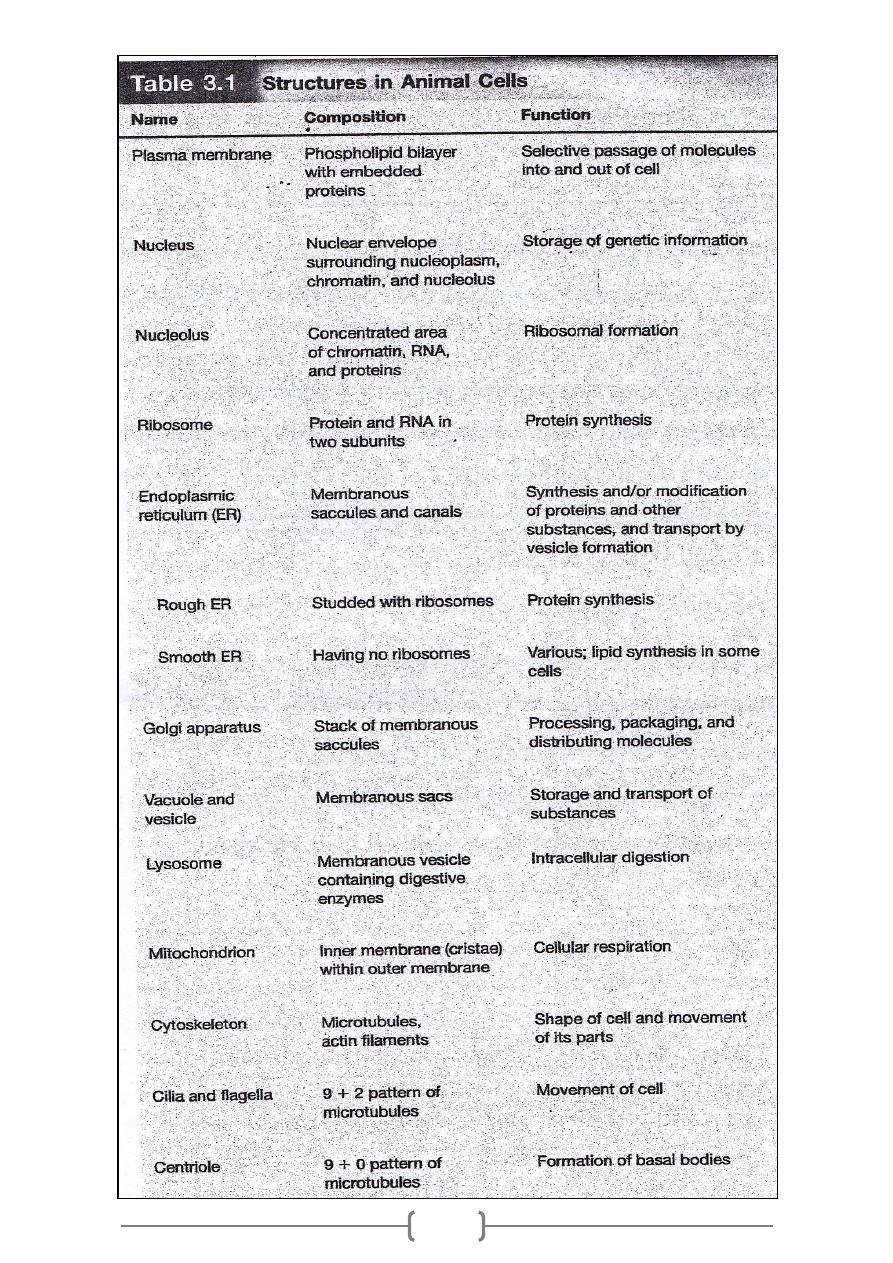
43
